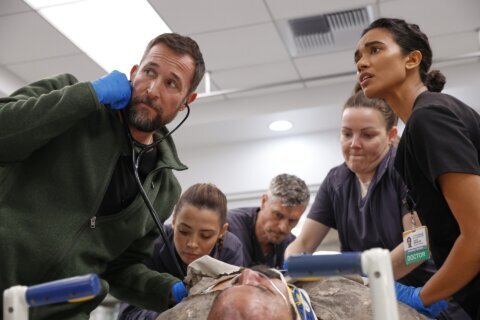“Barbie” and “Oppenheimer” have blockbuster competition at the box office this weekend as “Teenage Mutant Ninja Turtles: Mutant Mayhem” hopes to bring families to movie theaters like “The Super Mario Bros. Movie.”
Directed by Jeff Rowe (“The Mitchells vs. The Machines”), the computer-animated film by Nickelodeon Movies and Point Grey Pictures is co-written by “Superbad” duo Evan Goldberg and Seth Rogen, who voices Bebop alongside John Cena as Rocksteady, Ayo Edebiri as April O’Neil, Jackie Chan as Splinter, Paul Rudd as Mondo Gecko, Maya Rudolph as Cynthia Utrom, Rose Byrne as Leatherhead and Giancarlo Esposito as Baxter Stockman.
If those names ring a bell, it’s probably because you were raised on those characters, watching them on TV with a bowl of cereal, begging your parents to go see their movies, battling them in video games, or smashing them together as action figures. So, it’s time to reflect on what the Heroes in a Half Shell have meant to a generation.
Based on the 1984 comic book by Kevin Eastman and Peter Laird of Mirage Studios in New Hampshire, the Ninja Turtles were originally meant as a spoof of other superheroes. Rather than flying gods in tights, these were sewer-dwelling turtles mutated into human-sized crime-fighters under the ninja guidance of Master Splinter, a mutated rat sensei named Hamato Yoshi, who battles his nemesis Oroku Saki a.k.a Shredder leading the evil Foot Clan.
However, it wasn’t until the animated TV series “Teenage Mutant Ninja Turtles” (1987-1996) that the characters became household names in our living rooms, teaching kids that Leonardo leads, Donatello does machines, Raphael is cool but rude and Michelangelo is a party dude. It’s safe to say most folks know the names Leonardo, Donatello, Raphael and Michelangelo as pizza-loving turtles rather than esteemed artists in world history.
The series inspired countless childhood pizza parties and a successful line of action figures by the toy company Playmates, at one point rivaling G.I. Joe in toy sales, as chronicled in Netflix’s “The Toys That Made Us.” The Konami video games were also wildly popular in arcades and on the Nintendo Entertainment System. I still remember the cheat code for infinite lives: Up, Up, Down, Down, Left, Right, Left, Right, B, A, Select, Start.
Thus, kids were primed for the movie “Teenage Mutant Ninja Turtles” (1990), an underrated gem by New Line Cinema with Jim Henson’s animatronic costumes and Elias Koteas as Casey Jones. My dad took us to see it, but we arrived 10 minutes late, so we played in the parking lot for two hours until the next showing. The film feels like a gritty cult classic, but it was the year’s fourth top grosser behind “Ghost,” “Pretty Woman” and “Home Alone.”
It spawned the sequel “Teenage Mutant Ninja Turtles II: The Secret of the Ooze” (1991), replacing Judith Hoag with Paige Turco as April O’Neil and co-starring David Warner as a T.G.R.I. scientist, Ernie Reyes Jr. as pizza delivery boy Keno and Kevin Nash as Super Shredder. It’s best remembered for its “Ninja Rap” soundtrack with Vanilla Ice rapping, “Go, ninja, go, ninja, go!” as the turtles battle Tokka and Rahzar (not Bebop and Rocksteady).
The third installment, “Teenage Mutant Ninja Turtles III” (1993), was a disappointment as the turtles transported back in time to feudal Japan, earning the lowest Rotten Tomatoes score of the franchise (19% critics and 33% audience). The computer-animated reboot “TMNT” (2007) wasn’t much better, followed by a pair of lame Megan Fox flicks: “Teenage Mutant Ninja Turtles” (2014) and “Teenage Mutant Ninja Turtles: Out of the Shadows” (2016).
After 30 years of the franchise in the sewer, here’s hoping “Mutant Mayhem” restores the “Turtle Power” with slick new animation and a script that’s getting solid reviews so far from critics. Nickelodeon is taking advantage of the release by making the ’80s animated TV series available to stream. If you’re willing to forget the previous rocky reboots, “Mutant Mayhem” reminds us that “forgiveness is divine, but never pay full price for late pizza.”








